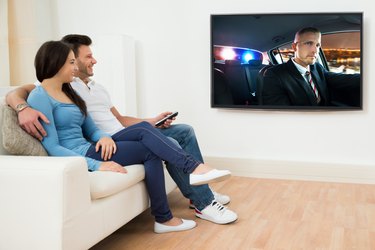
Back in the days of cathode ray tube televisions, a good, sturdy set from a respectable manufacturer could easily last 20 years. When flat-screen televisions first appeared on the scene, they drew upon relatively new and unrefined technologies, meaning high failure and defect rates. Over time the technology has matured, however, and today you can once again buy a television that has a good chance of lasting 20 years. LED sets promise to be some of the most long-lived televisions on the market.
100,000 Hours
Video of the Day
The true average lifespan of LED television sets remains to be seen, as of 2011, because the technology is still young. Some manufacturers, like Samsung, claim that the actual LEDs in some of their LED television sets will supply approximately 100,000 hours of useful life. At six hours of use every day, that works out to approximately 45 years of service. In other words, it's likely that your LED television will fail because of some other component instead of the LEDs themselves.
Video of the Day
Variety
The realities of mass production mean that a few of the units rolling off the line are lemons, doomed to fail much younger than they should. Whether you get a long life out of your TV depends somewhat on this element of chance, but you can influence the odds in your favor by buying a respected brand name, which lowers your chance of getting a lemon, and by taking good care of your set at home, which lowers your chance of aggravating any defects lurking inside your set.
Heat
Excessive heat kills electronics. Theoretical lifespan projections assume that you will keep your LED television well-ventilated and protected from heat sources such as sunlight, heating vents, lamps and other large electronics. To prolong the lifespan of your LED television, avoid these heat traps; keep the ambient room temperature between 65 to 75 degrees Fahrenheit.
LCD and Plasma
LED televisions are a special class of LCD televisions. They differ in that the older LCD technology uses cold cathode fluorescent lamps to light up the liquid crystal screen, while LED sets use thousands or millions of tiny LEDs, or light-emitting diodes. LEDs consume significantly less power than CCFLs. They generate less heat and don't burn out nearly as quickly as CCFLs, meaning that LED sets tend to last much longer than LCD sets.